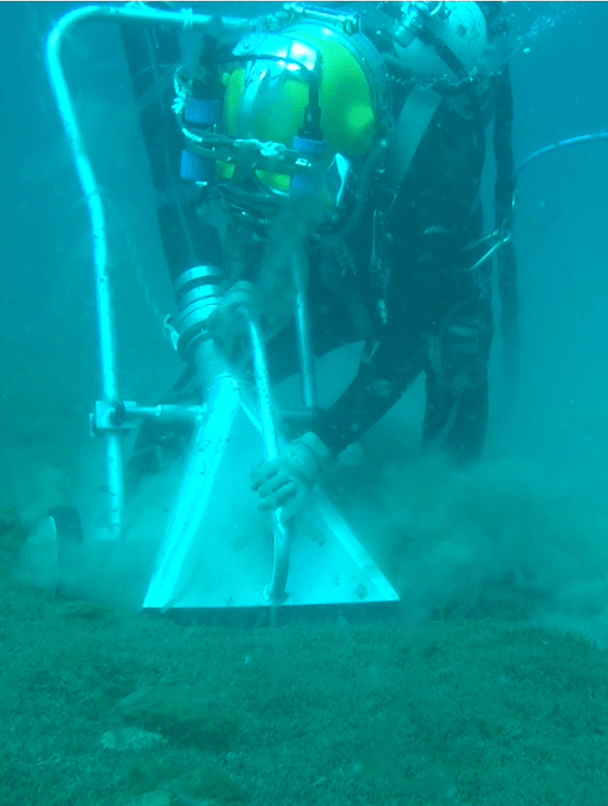Aotea suction dredge trials
Stage one of the first trial operation has wrapped up this week in Tryphena Harbour at Aotea Great Barrier Island.
A team from NIWA, the Cawthron Institute, and suction dredge firm Bay Underwater Services, with the support of mana whenua, have spent the past 10 days removing the pest seaweed from three defined areas in Schooner Bay, Shoal Bay and Puriri Bay.
Divers used a device like a large vacuum cleaner to suck up all visible caulerpa in marked plots on the seafloor at the three locations. They were able to clear approximately 60 square metres of exotic caulerpa an hour, and around 17 tonnes of the seaweed were removed and securely transported to shore where it was disposed of on a rural property near Tryphena.
Following the suction, parts of the treated plots (approximately 100 square metres in each area) were covered with matting and chlorine granules were inserted underneath. The mats were lifted the following day. This will enable us to see over time how well suction alone works, compared with the additional use of a chlorine and mat treatment.
All the treated sites will be visited in a month and then after two months to observe the treatment effectiveness, whether it has affected other species in the target zones, and whether any exotic caulerpa has regrown.
It is too early to fully understand the practicality and effectiveness of the method against the large-scale infestations present in New Zealand. For perspective, at Aotea alone, there are some 820 hectares of caulerpa-covered seabed (equivalent to around 800 rugby fields). The trial cleared just one-tenth of a hectare – the area between the try line and the 22 on one rugby pitch.
We will need to wait for the full scientific analysis of this trial, and one at Te Rāwhiti, before we can determine where suction dredging will fit in the future management of exotic caulerpa.
Treatment at Port Fitzroy, Aotea
Following their work in Tryphena, the suction dredge crew relocated to the Man of War Passage near Port Fitzroy where they used the suction dredge on two small but key areas where vessels typically visit. These patches of exotic caulerpa were discovered by NIWA in July.
Te Rāwhiti planning
Northland Regional Council and mana whenua in Northland are well underway planning trials of suction dredging in the Te Rāwhiti Inlet.
A contractor is being secured to do this project and it’s hoped that the actual dive work will start towards the end of October.
Operations will be similar to what’s been done at Aotea, and the preferred supplier will be able to tap into what’s been learnt there.
We are also working with Northland Regional Council to start wider surveillance checks for the presence of exotic caulerpa across the Northland region.
Kawau Island hand removal
Partnering with Ngati Manuhiri, NIWA divers were in the water at Iris Shoal off Kawau Island in August and September, attempting removal of exotic caulerpa by hand.
This work has now been paused as progress was very slow and it became evident that hand removal was not going be effective for use at this scale.
Even though caulerpa coverage is patchy at Kawau, it still covers more than 18 hectares and the divers were only able to clear .1 (one tenth) of a single hectare in two weeks.
NIWA divers will return to the waters at Kawau next week to check the area that was treated to see how successful the removal has been.
We are now talking to Ngāti Manuhiri on other options for the removal of caulerpa at Kawau Island.
Strategic Technical Advisory Group (TAG)
Throughout the response to exotic caulerpa, groups of scientific and technical experts have been gathered to provide advice on aspects of the programme.
Most recently, a TAG was assembled to advise on what management of exotic caulerpa should look like in the long-term future and a national strategy to achieve this.
The group has been tasked with providing recommendations on future areas of research, how various tools can be used for different scenarios, and the feasibility of the success of these tools. There are experts in mātauranga Māori in the group who are providing important perspectives.
We expect a report from the TAG in the coming month.
You can help stop the spread of exotic caulerpa
Know where exotic caulerpa is – check: www.biosecurity.govt.nz/caulerpa for maps, information about legal restrictions in some areas on some boating and fishing activities, what caulerpa looks like and how you can prevent spread.
Areas with both legal controls (Controlled Area Notices) and rāhui that prevent anchoring and fishing activities are: Aotea (Blind Bay, Whangaparapara Harbour and Tryphena Harbour); the southwestern coastline of Ahuahu Great Mercury Island; and Te Rāwhiti Inlet in the Bay of Islands.
A rāhui is also in place at Waiheke Island 1km offshore from Thompson’s Point and in Onetangi Bay.
There is no rāhui or controlled area at Kawau Island but it’s best to avoid anchoring at Iris Shoal.
What to do
Respect the rules about anchoring and fishing in those areas
When anchoring and fishing in other areas, check your anchor, anchor chain and gear for seaweed before you move on. If you find seaweed, remove it, bag it if you can and dispose of it safely to the rubbish on land. If you can’t do this, return it to the waters it came from.
If you think you see exotic caulerpa, note the location, take a photo and report it to Biosecurity New Zealand on 0800 80 99 66 or online at report.mpi.govt.nz
Here’s the “How to identify caulerpa and report it” video.
There is also a laminated water-resistant ID card.
Identification guide for divers



